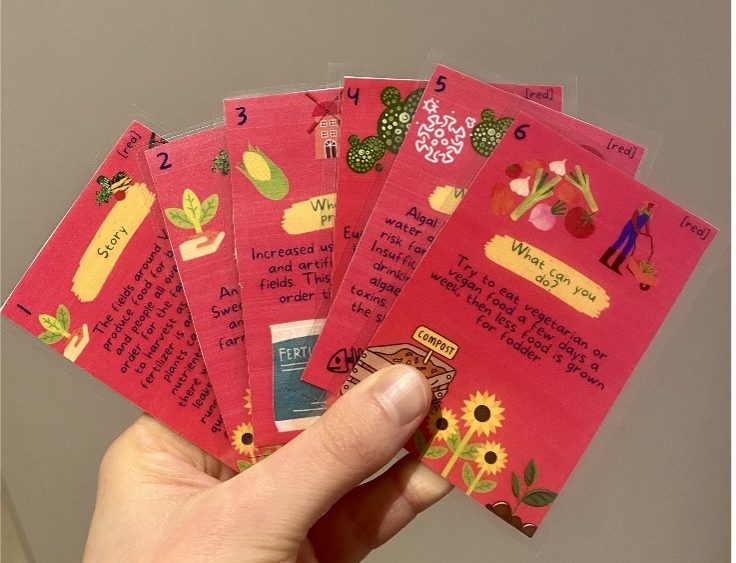In 2022, together with my peer students in the Environmental Studies and Sustainability Science program (LUMES), I designed the game “Go Fish in Vombsjön” to highlight issues related to more sustainable water usage at Lake Vombsjön in Skåne. It’s a card game primarily aimed at children from middle school or older but can just as well be played and enjoyed by adults, regardless of their level of education or knowledge.
The best thing about the game is that learning comes along with it. It doesn’t require any special knowledge or even an interest in sustainability issues to participate. Instead, the appeal lies in the enthusiasm for participating in a social game and the desire to beat one’s opponents. Hereafter, I will briefly explain the process that made the game possible, how we designed it, and finally share my insights, as well as how you could use the game “Go Fish in Vombsjön” with your friends, colleagues, or in education.
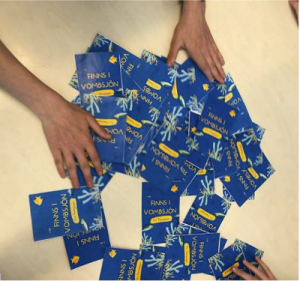
Between 2021–2023, I studied the Environmental Studies and Sustainability Science master’s program at Lund University. During our second semester in the “Knowledge to Action” course, our task was to highlight a sustainability problem in our local area, document it, and clarify the process for identifying a solution to the problem.
The working group I was part of had already initiated a dialogue with the ARNA association in the UngScishop project. ARNA works to spread knowledge about sustainability challenges through ARt and NAture. Within the UngScishop project, they work with middle school students from schools around Vombsjön to teach them about sustainability related to the area. (see more from ARNA at www.arna.nu)
Our contact with ARNA made us students curious about Vombsjön, which is the water source for Lund Municipality and several other municipalities in Skåne. An intensive period of interviews with local stakeholders around Lake Vombsjön, as well as thorough research of official documents and academic sources, enabled us to identify several different aspects that all influenced the water quality in the lake.
The group collectively concluded that a game is a good method for learning about complex subjects and engaging across generational boundaries. The well-known game “Go Fish” provided the framework for the game’s structure, with the rules being largely the same. By using an existing structure, it’s easy to learn the game, and it only takes a few minutes to start an engaging and entertaining game.
The card game consists of six categories, with each category reflecting a problem that negatively affects the water in Vombsjön. Each category consists of 5 steps that reflect the different letters in the DPSIR method, plus one card that explains the story behind the problem.
The DPSIR method is a method used in sustainability studies and is mentioned in Burkhard & Müller, 2008 *, where the different letters stand for:
D – Drive, P – Pressure, S – State, I – Impact, R – Response
To make the game accessible and move away from an academic and sometimes inaccessible jargon, we chose to translate the meaning of the letters as follows:
Drive: The root cause
Pressure: What’s the problem?
State: Current situation
Impact: What does it lead to?
Response: What can you do?
Thus, we created a deck of cards with seven categories, where each category consisted of six cards (DPSIR + a story card), and all the cards together in a category formed a family. The player who collected the most families at the end of the game wins.
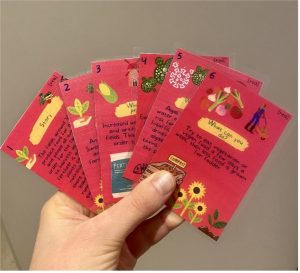
How can the game be used?
In the introduction to this post, I mentioned that the game can be used as a social game or for educational purposes. To date, the game has been played by staff at LUCSUS and students in the LUMES master’s program, as well as with around 150 middle school students in schools around Skåne.
The idea of the game is to create understanding and insight into how complex sustainability problems are interconnected but also to provide examples of how we ourselves have power over its structural problems and that sometimes we can influence the outcome by changing our everyday actions and behaviours. At the same time, it was important for the game to be engaging and entertaining. This way, we could attract and reach groups of people who would not otherwise be exposed to this type of information.
Each card in the deck tells a story. The story describes a problem, what affects the problem, and what we can ideally do about it, thereby contributing to change. By reading one of the stories at the end of each game round and then discussing it in the group, the problems are made visible and easily accessible and understandable. We, the creators of the game, hope that each round will lead to insights and hopefully provoke discussions outside the classroom. In the long run, the game can change behaviour and contribute to more sustainable water usage around Vombsjön.
On one occasion, a class from Sjöbo got to play “Go Fish in Vombsjön”. One of the teachers shared the insight that the game doesn’t need to be played in its entirety; selected parts can form the basis for discussions and assignments in the classroom and can thus be included in the regular teaching schedule. This is beneficial since time and the set curriculum can be restricting factors when trying to introduce a new topic or activity in schools.
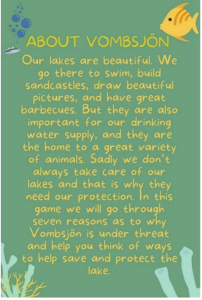
Lessons learned and critique
After each time we play-tested with a group of students, we were eager to receive feedback and any criticism. Already, at the beginning of the design process, we made sure to give each card a number, and each family should be recognizable through its colour. The colour is also printed in text, so the game can accommodate the different needs of the players and misunderstandings about the colours don’t arise. (Which is an important aspect of the game). One comment we received was that each family in the deck should have a name that reflects and summarizes the problem and the described story. Depending on the age group, the amount of text on each card can be too abundant and sometimes difficult to understand and would therefore benefit from being further shortened for the younger players’ sake.
Where can I find the game?
During the course of the master’s program LUMES, a deck of cards was produced in English and one in Swedish. Over time, several decks of cards have been produced in Swedish under the name “Finns i Vombsjön”. Currently, there are about 10 decks of cards, 2 of which are now found in classrooms in Skåne. Each deck consists of 47 cards, with each card being manufactured by glueing the back and front together, cutting out each card, and laminating them by hand. This is a time-consuming process, and I hope to make the game more widely available through free downloads of PDF files, where you can make as many games as you want on your own.
Would you like to borrow a game today? Then feel free to contact me at annanohed@gmail.com.
Here you can read further about our collaboration with ARNA and watch a video about the game. https://ungscishop.se/lunds-universitet/lumes-studenter
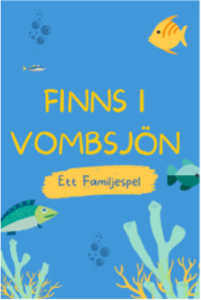
*Burkhard B. & Müller F. Encyclopedia of Ecology Ecological Indicators: Driver–Pressure–State–Impact–Response. Elservier. 2008. 2: 967-970.

